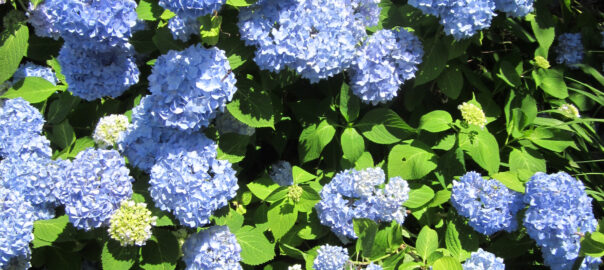
At this time of the year there are so many beautiful flowers in bloom in our garden. They draw butterflies and other beneficial pollinators to the borders.
Perennials include the daylilies, Japanese irises, hostas, daisies, and balloon flowers. Among the bushes and shrubs are roses, spireas, and viburnums. Plus, I mustn’t forget the annuals like geraniums, coleus, marigolds, petunias and begonias.
But, the real “attention getters” this year are the hydrangeas, especially the Endless Summer ones (Hydrangea macrophylla ‘Bailmer’). And ours just happen to be blue.
The color of the blooms depends on the soil pH, which can be amended. Acid soils produce blue flowers, and alkaline soils produce pink ones. Some gardeners apply an acid fertilizer in the early spring to ensure blue results all summer long.
The Endless Summer Hydrangea was the first hydrangea found that blooms both on the previous year’s branches as well as on the new season’s growth. The compact size of the shrub (approximately 4 feet tall and wide) will fit almost any landscape. It really makes a superior accent or specimen plant.
The blossoms linger a long time in the garden, and the large “mopheads” make great cut flowers for beautiful arrangements. Some designers hang them upside-down to dry out and create long-lasting indoor displays.
We recently read: “Mophead hydrangeas are also known as French hydrangeas, which is ironic, since this shrub is native to Japan. Many of the early breeding efforts to develop mophead hydrangeas occurred in France, so they became widely known as French hydrangeas.”
If you translate the botanical name from the Latin, Hydrangea macrophylla gives some clues about this shrub. Hydrangea contains the root that refers to water (hydra), and macrophylla literally means “big leaf.” As the name suggests, Hydrangea macrophylla is a water-loving plant with big leaves.
We look forward to enjoying our blue flowers all summer long, especially if we remember to deadhead regularly. We are told to prune immediately after flowering by cutting back flowering stems to a pair of healthy buds. However, some gardeners choose not to deadhead at all.
Incidentally, continuing our fixation with all things blue, July just happens to be “National Blueberries Month.” So, a time to enjoy for sure!
Loving the Blues!

